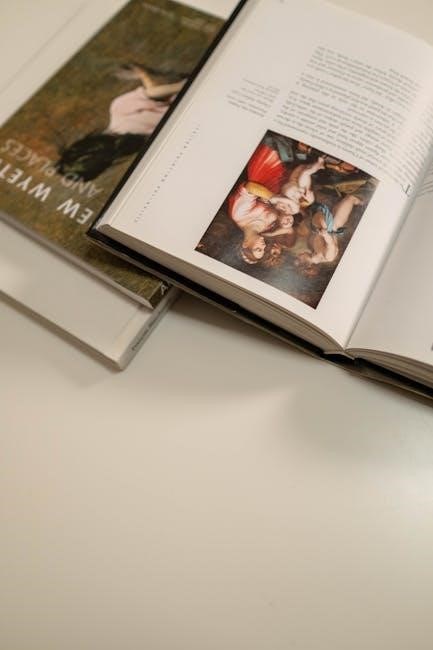Mary Lynn Rampolla: A Pocket Guide to Writing in History
Mary Lynn Rampolla’s “A Pocket Guide to Writing in History” is an indispensable resource for students navigating the intricacies of historical research and writing. It offers guidance on assignments and critical thinking.
Overview of the Pocket Guide
Rampolla’s “A Pocket Guide to Writing in History” is a concise yet comprehensive manual designed to equip students with the essential skills for producing effective historical writing. Serving as a quick reference tool, it addresses the diverse writing assignments encountered in history courses, from brief essays to extensive research papers.

The guide emphasizes critical reading, enabling students to dissect historical narratives and synthesize information effectively. It provides practical strategies for evaluating sources, documenting research accurately, and avoiding plagiarism, a crucial aspect of academic integrity.
Furthermore, the “Pocket Guide” offers detailed advice on constructing well-reasoned arguments, organizing evidence, and crafting clear, concise prose. Its accessibility makes it suitable for both introductory and advanced history courses, ensuring students have a reliable resource throughout their academic journey. By focusing on clarity and practicality, Rampolla empowers students to approach historical writing with confidence and competence.
Purpose of the Guide
The primary purpose of “A Pocket Guide to Writing in History” is to provide students with a readily accessible and comprehensive resource for mastering the art of historical writing. It aims to demystify the writing process, offering clear and concise guidance on all stages, from initial research to final revisions.
The guide seeks to equip students with the critical thinking skills necessary to analyze historical sources effectively, formulate compelling arguments, and present their findings in a scholarly manner. By emphasizing the importance of accurate documentation and ethical research practices, it aims to foster academic integrity.
Ultimately, the “Pocket Guide” strives to empower students to approach history assignments with confidence, enabling them to develop their writing abilities and achieve academic success. It serves as a valuable tool for both introductory and advanced students, providing support throughout their academic journey and fostering a deeper understanding of historical scholarship.
Target Audience
“A Pocket Guide to Writing in History” is primarily designed for undergraduate students enrolled in history courses, ranging from introductory surveys to advanced seminars. It caters to students at all levels of writing proficiency, offering support for those new to historical research and guidance for those seeking to refine their skills.
The guide is also a valuable resource for students in other disciplines who are undertaking research projects involving historical analysis or argumentation. Its comprehensive coverage of research methodologies, citation styles, and writing strategies makes it a useful tool for anyone engaging with historical sources.
Furthermore, instructors of history courses may find the guide a helpful resource for teaching writing skills and setting expectations for student assignments. It provides a common framework for understanding the principles of historical writing and can be used to supplement classroom instruction.
Key Features and Benefits
“A Pocket Guide to Writing in History” boasts several key features that make it an invaluable resource for students. Its concise and accessible format allows for quick reference to essential information, making it easy to find answers to specific questions about research, writing, and citation.
The guide provides clear and practical advice on a wide range of topics, including developing research questions, conducting effective research, constructing strong arguments, and documenting sources accurately. It also offers guidance on avoiding plagiarism and adhering to academic integrity standards.
Moreover, the guide includes numerous examples and models of effective historical writing, illustrating key concepts and providing students with concrete strategies for improving their own work. Its focus on critical thinking skills helps students to analyze historical sources effectively and develop nuanced interpretations of the past.

About the Author: Mary Lynn Rampolla
Mary Lynn Rampolla, the author, is an associate professor of history at Trinity Washington University. Her scholarly work and teaching experience inform the practical guidance offered in the “Pocket Guide”.
Rampolla’s Academic Background
Mary Lynn Rampolla’s strong academic background significantly contributes to the authority and practicality of “A Pocket Guide to Writing in History.” She earned her Ph.D. from the University of Toronto, a testament to her dedication to historical scholarship and rigorous academic training. Her doctoral studies provided her with a deep understanding of historical research methodologies, critical analysis, and effective writing strategies, all of which are essential components of the guide.
Prior to her doctoral work, Rampolla undoubtedly engaged in extensive coursework and research, honing her skills in historical interpretation and argumentation. This comprehensive academic foundation equipped her with the expertise necessary to address the challenges students face when writing about history. Her advanced degree underscores her commitment to academic excellence and her ability to provide students with reliable and insightful guidance on their historical writing endeavors. The “Pocket Guide” benefits immensely from her scholarly preparation, making it a valuable resource for students at all levels.
Rampolla’s Affiliation with Trinity Washington University
Mary Lynn Rampolla’s affiliation with Trinity Washington University as an associate professor of history plays a crucial role in shaping the content and approach of “A Pocket Guide to Writing in History.” Her position at Trinity Washington University provides her with direct, ongoing experience working with students from diverse backgrounds and academic levels, allowing her to understand their specific needs and challenges when it comes to writing about history.

This firsthand experience informs her writing in the “Pocket Guide,” ensuring that the advice and strategies she offers are practical, relevant, and accessible to students. Her role as an educator allows her to continuously refine her understanding of effective teaching methods and adapt her guidance to meet the evolving demands of historical scholarship. Rampolla’s affiliation with Trinity Washington University strengthens the “Pocket Guide’s” credibility and makes it a valuable resource for students seeking clear, concise, and applicable advice on historical writing.
Rampolla’s Scholarly Work

Mary Lynn Rampolla’s scholarly work significantly enriches “A Pocket Guide to Writing in History,” providing a solid foundation of expertise and credibility. As an accomplished historian, her research and publications demonstrate a deep understanding of historical methodologies, source analysis, and effective communication of historical arguments. This scholarly background allows her to offer students insightful guidance on conducting rigorous research, evaluating evidence critically, and constructing well-supported historical narratives.
Her expertise ensures that the “Pocket Guide” reflects current best practices in the field of history. Rampolla’s scholarly work enables her to address complex issues related to historical interpretation, historiography, and the responsible use of sources. By drawing upon her own research experiences, she can provide students with practical advice on navigating the challenges of historical inquiry and producing original, well-informed scholarship. Ultimately, Rampolla’s scholarly work elevates the “Pocket Guide” beyond a mere writing manual, transforming it into a valuable resource for aspiring historians.

Content of “A Pocket Guide to Writing in History”
This guide covers essential aspects: historical writing assignments, research paper guidance, critical reading skills, proper source documentation, and avoiding plagiarism. It’s a comprehensive resource for history students.
Writing Assignments in History Courses
History courses often require diverse writing assignments, and Rampolla’s guide expertly prepares students for these challenges. The guide offers practical advice on tackling essays, research papers, book reviews, and document analyses, common tasks in history education.
It emphasizes understanding assignment prompts, developing strong arguments, and structuring coherent narratives. Students learn how to effectively use primary and secondary sources to support their claims, a crucial skill for historical writing.
Furthermore, the guide provides guidance on crafting compelling introductions and conclusions, ensuring clarity and precision in language, and adhering to specific citation styles. By mastering these elements, students can confidently approach any writing task in their history courses.
The guide also underscores the importance of revision and proofreading, helping students refine their work and eliminate errors. Ultimately, this section equips students with the tools to excel in their history writing assignments.
Research Paper Guidance
Rampolla’s “A Pocket Guide to Writing in History” provides invaluable guidance on crafting effective research papers, a cornerstone of historical scholarship. The guide meticulously walks students through each stage of the research process, from selecting a compelling topic to presenting well-supported arguments.
It offers practical advice on conducting thorough research, evaluating sources critically, and synthesizing information from diverse perspectives. Students learn how to formulate research questions, develop strong thesis statements, and construct logical outlines to structure their papers effectively.

Furthermore, the guide emphasizes the importance of proper citation and documentation to avoid plagiarism and give credit to original authors. It includes detailed explanations of various citation styles commonly used in history, such as Chicago and MLA.
By following Rampolla’s guidance, students can produce well-researched, meticulously documented, and persuasively argued research papers that demonstrate their understanding of historical concepts and methodologies.
Critical Reading Skills
“A Pocket Guide to Writing in History” dedicates significant attention to cultivating critical reading skills, essential for engaging with historical texts effectively. The guide equips students with strategies to analyze sources, identify biases, and interpret arguments within their historical context.
It emphasizes the importance of questioning assumptions, evaluating evidence, and considering alternative perspectives. Students learn how to distinguish between primary and secondary sources, assess the credibility of authors, and recognize the influence of historical events on the content and interpretation of texts.

The guide provides practical exercises and examples to help students develop their ability to dissect historical narratives, identify underlying themes, and synthesize information from multiple sources. By mastering these critical reading skills, students can engage with historical scholarship in a more meaningful and insightful way.
Ultimately, Rampolla’s guide empowers students to become discerning readers who can critically evaluate historical arguments and form their own informed opinions.
Documenting Sources
A core component of “A Pocket Guide to Writing in History” is its comprehensive guidance on documenting sources, a fundamental aspect of academic integrity and historical scholarship. The guide meticulously explains various citation styles, including MLA, Chicago, and Turabian, providing clear examples for each.
It covers the proper formatting of footnotes, endnotes, and bibliographies, ensuring students can accurately credit the sources they use in their research. The guide emphasizes the importance of consistency and attention to detail in documentation, helping students avoid unintentional plagiarism and maintain scholarly rigor.
Furthermore, it addresses the nuances of citing different types of sources, such as books, articles, websites, and primary documents. Students learn how to create accurate and complete citations that allow readers to easily locate the original sources used in their research.
By providing clear and concise instructions on documenting sources, Rampolla’s guide empowers students to produce well-researched and properly cited historical writing.
Avoiding Plagiarism
“A Pocket Guide to Writing in History” dedicates significant attention to avoiding plagiarism, a critical concern for students in historical research. The guide clearly defines plagiarism, explaining its various forms, including direct copying, paraphrasing without attribution, and submitting someone else’s work as one’s own.
It emphasizes the importance of understanding and adhering to academic honesty policies. The guide provides practical strategies for avoiding plagiarism, such as taking detailed notes, properly paraphrasing and summarizing sources, and always citing the original source of information;
Rampolla’s guide also addresses the ethical considerations surrounding plagiarism, highlighting its impact on academic integrity and the credibility of historical scholarship. Students learn how to use citation management tools effectively and understand the importance of giving credit where it is due.
By providing clear guidelines and practical advice, the guide equips students with the knowledge and skills necessary to avoid plagiarism and produce original, ethical historical writing.

Editions and Availability
“A Pocket Guide to Writing in History” has multiple editions, reflecting its continued relevance. It’s widely available through online retailers like Amazon and various textbook marketplaces, making it easily accessible.
Eighth Edition Details
The Eighth Edition of “A Pocket Guide to Writing in History” by Mary Lynn Rampolla represents a significant update to this essential resource for history students. Published by Bedford/St. Martins, this edition maintains the guide’s concise yet comprehensive approach to research and writing in the discipline of history.
Specifically tailored for both introductory and advanced courses, the Eighth Edition provides practical guidance on a range of topics, including understanding typical history assignments, honing critical reading skills, and effectively evaluating and documenting sources. It offers step-by-step instructions for navigating the research process.
Students will also find detailed advice on avoiding plagiarism, a crucial aspect of academic integrity. The book’s organization allows quick reference to specific writing challenges, making it a valuable tool for students throughout their history coursework. This edition ensures students have the tools needed to succeed.
Availability on Amazon.com
“A Pocket Guide to Writing in History” by Mary Lynn Rampolla is readily accessible for purchase on Amazon.com. This online availability ensures that students and educators can easily acquire this valuable resource, regardless of their location or access to physical bookstores. Amazon.com typically offers the guide in various formats, including paperback and digital (Kindle) versions.
Customers can benefit from Amazon’s convenient features, such as user reviews and ratings, which provide insights into the book’s effectiveness and value. The platform also offers competitive pricing and shipping options, making it an affordable and efficient way to obtain the guide. Furthermore, Amazon’s search functionality allows users to quickly locate the specific edition they need, whether it’s the latest release or an earlier version.
The book’s presence on Amazon.com enhances its visibility and accessibility, solidifying its position as a go-to resource for history students seeking guidance on writing and research.
ISBN Information
The International Standard Book Number (ISBN) is a crucial identifier for “A Pocket Guide to Writing in History” by Mary Lynn Rampolla. Each edition of the guide has a unique ISBN, ensuring accurate identification and ordering. For example, the Eighth Edition has ISBN 9780312610418.
This number is essential for students, librarians, and booksellers to distinguish between different versions and formats of the book. The ISBN can be used to search for the book in online databases, library catalogs, and bookstore systems. When purchasing the guide, verifying the ISBN ensures that you are obtaining the correct edition and avoiding any confusion.
Different formats, such as paperback or digital versions, will also have separate ISBNs. Always refer to the ISBN when requesting or purchasing the book to guarantee you receive the intended version. It’s a simple yet vital step in ensuring access to the right resource for your history writing needs.

Relevance for Students
“A Pocket Guide to Writing in History” is highly relevant for students. It offers essential support for history coursework. It serves as a reference tool and comprehensive resource.
Reference Tool for History Students
Mary Lynn Rampolla’s “A Pocket Guide to Writing in History” stands as an invaluable reference tool meticulously crafted for history students at all academic levels. Its concise yet comprehensive nature offers students a readily accessible resource. It helps navigate the complexities inherent in historical research and academic writing.
The guide’s strength lies in its ability to provide clear, practical guidance on a spectrum of tasks encountered in history courses. From deciphering assignment prompts to mastering the art of research papers, the guide equips students with the skills needed for success. The guide also includes critical reading skills, proper documentation, and avoiding plagiarism.
The pocket-sized format enhances its utility, allowing students to carry a wealth of information. Its compact design ensures that it remains a constant companion, readily available for consultation. This makes it easier to grasp essential concepts and refine academic performance.
Use in Introductory and Advanced Courses
“A Pocket Guide to Writing in History” by Mary Lynn Rampolla is versatile and beneficial in both introductory and advanced history courses. Its content is structured to meet the diverse needs of students, regardless of their academic level or familiarity with historical research and writing.
For students in introductory courses, the guide provides a foundation by demystifying the fundamental principles of historical analysis and argumentation. It introduces basic concepts, such as constructing well-supported arguments. It also introduces proper citation methods and navigating primary and secondary sources. This empowers novice historians to approach their assignments with confidence and clarity.
In advanced courses, the guide serves as a sophisticated resource for refining research methodologies and writing techniques. It helps delve deeper into complex historical debates. It also provides guidance on crafting nuanced interpretations and conducting original research.
Comprehensive Coverage of Research and Writing
“A Pocket Guide to Writing in History” distinguishes itself through its comprehensive exploration of the historical research and writing process. Mary Lynn Rampolla meticulously addresses every facet of scholarly inquiry, ensuring students are well-equipped to tackle any assignment with confidence and competence.
The guide delves into the intricacies of formulating research questions. It also discusses conducting thorough investigations, and synthesizing diverse sources into a coherent narrative. It offers practical guidance on evaluating primary and secondary materials, interpreting historical evidence, and constructing persuasive arguments supported by credible sources.
Furthermore, the guide provides detailed instruction on various writing formats commonly encountered in history courses, from concise book reviews to extensive research papers. Students receive step-by-step advice on structuring their essays, developing strong thesis statements, and employing effective rhetorical strategies to engage their readers.